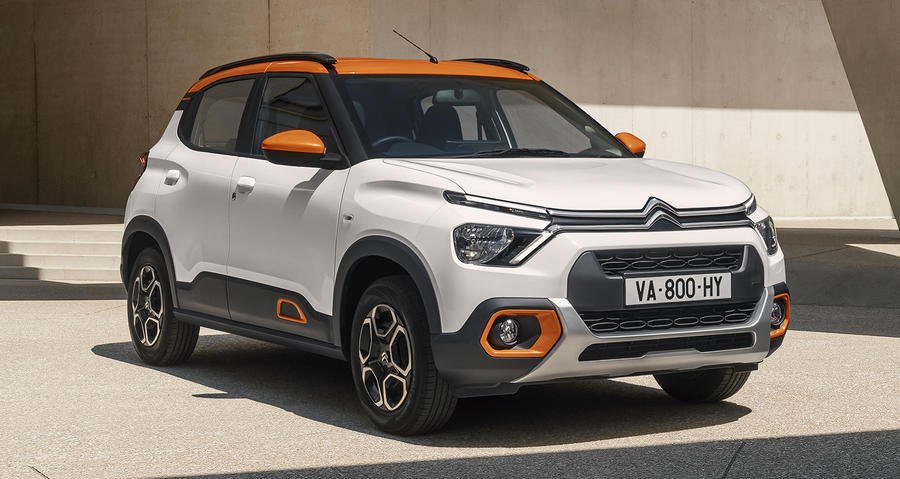Citroen targets crucial high-growth regions with affordable New C3

Citroën is targeting growth outside of Europe with a bold plan to capture a share of the developing Indian and South American markets, starting with an affordable rugged supermini: the 'New C3'.
The brand is aiming for 30% of its sales to be outside of Europe by the middle of this decade and is ramping up its presence in high-growth markets. India, for example, is projected to become the third-largest automotive market in the world with four million car sales a year by 2025.
The New C3 has been especially designed with a focus on affordability, durability and agility, because it is destined for use primarily in regions with challenging road surface and traffic conditions, compared with what the urban-oriented C3 faces in Citroën's Europe home market.
Although it occupies a similar footprint to the C3 available here, at 3980mm long and with a wheelbase of 2540mm, it has been styled with influence from larger SUVs and, as a result, more closely resembles the C3 Aircross. Crucially, at just under four metres in overall length, the New C3 is eligible for a lower tax rate in India, where excise duty is calculated according to size.
With raised suspension and large-diameter 25in tyres giving 180mm of ground clearance, and short overhangs allowing for favourable approach and departure angles, the New C3 offers a higher driving position than its European counterpart and can avoid underbody damage on rough surfaces. The rugged styling is functional as well as aesthetic: Citroën noted that the pavements in South America are particularly high so took extra measures to protect the mechanicals.
The New C3 is the first of three 'C-Cubed' cars created specifically for developing markets and will have a tangible styling influence on its range-mates, which will adopt a similar rugged ethos.
Inside, the New C3 offers a familiarly functional layout and majors on comfort and storage. It has five seats and a 315-litre boot and rear passengers get 653mm of leg room - the highest in the segment, Citroën says. Despite its value focus, the New C3 gets a 10.0in infotainment touchscreen with smartphone-mirroring functionality and comes equipped with various cubbies and charging facilities in recognition of the growing ubiquity of smartphones.
The New C3 is important in a global sense because it marks the beginning of Citroën's landmark push into crucial emerging markets, which could go some way to cementing it as a leading brand in the 14-strong Stellantis portfolio. Although it has been present in South America for several years, it is a newcomer to the Indian market, where it has sold exclusively the C5 Aircross SUV since 2019.
Citroën CEO Vincent Cobée said that, as a "generalist car maker", the firm will seek to provide good value in these markets, where cars are usually "the second largest purchase after the home" and, particularly in India, "owning a car is proof of social success and independence".
However, Citroën has detailed its Indian market aspirations just a week after Ford announced its shock exit from the region, citing under-utilisation of factories and uneconomical production costs. Asked how he can be sure Citroën won't face the same issues, Cobée told Autocar: "We all know India is a tough market. I have had the privilege of launching a number of models in India so I can speak with a bit of experience if not wisdom.
"When you introduce a vehicle in India, you need to address four things: A: localisation is the word. B: reassurance is the second needed word; there is a dominant player in India [Maruti Suzuki] which has been present for more than 40 years and covers more than 50% of sales, and has something to the tune of 10,000 sales points across the sub-continent.
"So for you to exist, you need to assure competitiveness, presence and parts availability. The third thing you need to do is be nimble and [the fourth is] flexible. If you build a brand-new greenfield plant and invest in a very expensive dealer network and wait for the sales to come, you will be hit by fixed costs before you can achieve viable revenues."
Citroën has therefore invested in a 'brownfield' factory to save on construction costs and has ramped up production gradually with the C5 Aircross (which sold just 50 units in August and is projected to account for just 500-1000 sales in 2021 overall). Cobée said the dealer network is "flexible and agile", too, and is tied to a mobile maintenance programme to better suit the sparsely populated areas of its target regions.
Notably, the New C3 is a petrol-only proposition, and Citroën has made no mention of an electrified variant, which is at odds with its rapid push to electrify its much larger European fleet.
Cobée said the vehicles on sale in India and Latin America could be "technically" electrified, but added: "Is the market ready? Not yet." There is a form of CAFE (Corporate Average Fuel Economy) legislation in India, and an energy usage regulation system in South America, which means the markets are already "going through the downward curve in terms of CO2 emissions". The priority in these markets, for the moment, is to reduce overall CO2 emissions before focusing on the sale of electrified cars.
